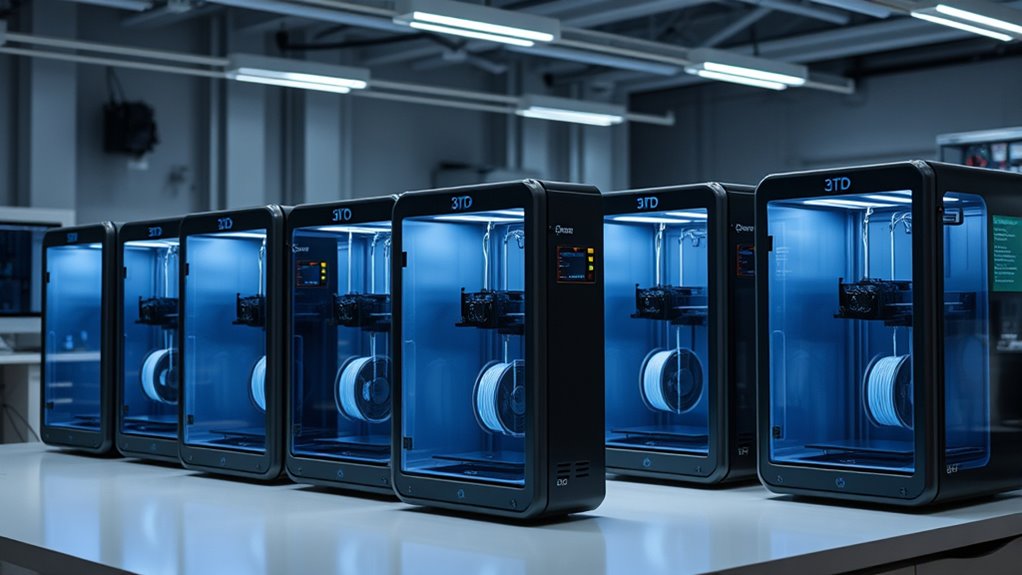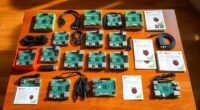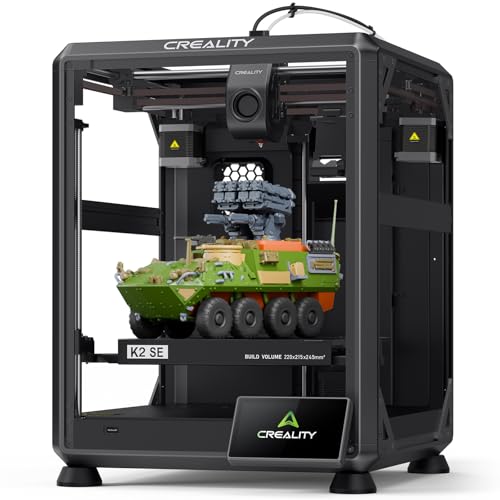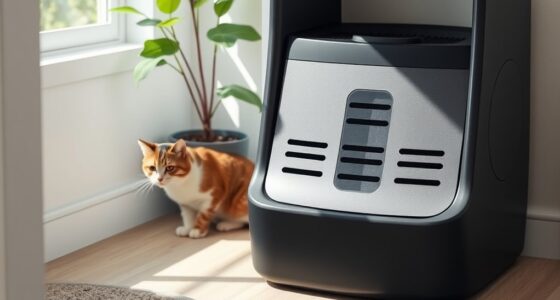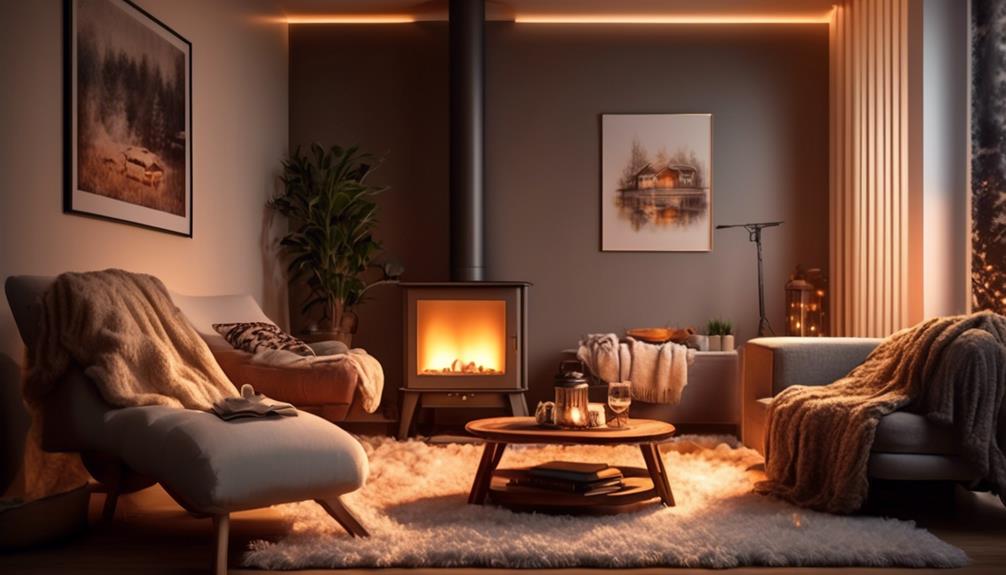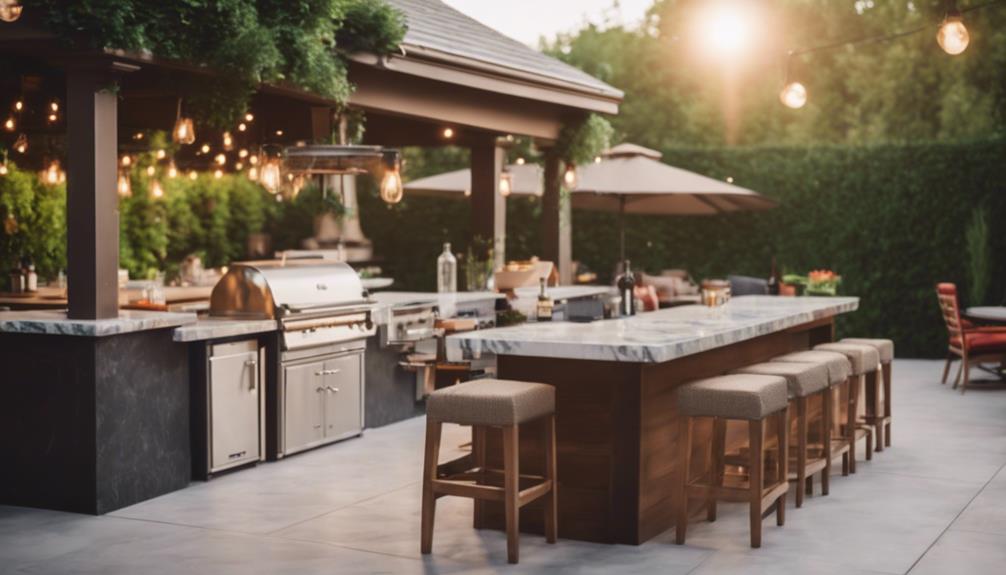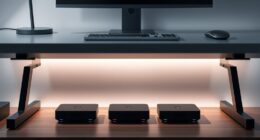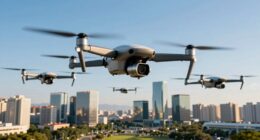If you’re searching for the top enclosed 3D printers of 2025 for safe, precise, and high-speed printing, I recommend considering models like the FLASHFORGE AD5M Pro, Creality K1 SE, ELEGOO Neptune 3 Pro, and Anycubic Kobra S1 Combo. These printers feature auto leveling, large build volumes, and advanced safety features, making them ideal for various projects. Keep exploring, and you’ll discover even more options tailored to your needs.
Key Takeaways
- Enclosed 3D printers ensure safety by containing fumes, filament debris, and hot components, reducing burn and injury risks.
- Advanced auto bed leveling and calibration features enhance print precision and reduce setup time for reliable results.
- High-temperature chambers and material compatibility support precise printing with ABS, PETG, nylon, and composite filaments.
- Integrated air filtration systems and safety interlocks improve indoor air quality and operational safety during printing.
- User-friendly interfaces, remote monitoring, and minimal maintenance make enclosed printers suitable for beginners and professionals alike.
FLASHFORGE AD5M Pro 3D Printer with High Speed & Precision
If you’re looking for a versatile and high-speed 3D printer suitable for both beginners and professionals, the FlashForge AD5M Pro stands out as an excellent choice. It can reach speeds up to 600mm/s, drastically reducing print times without sacrificing quality. The full-auto calibration and automatic bed leveling make setup straightforward, even for newcomers. Its enclosed design, with safety features like chamber cooling and noise reduction, creates a safe and quiet environment. Supporting multi-materials like TPU, ABS, and carbon fiber, it produces detailed, reliable prints with high precision. Overall, the AD5M Pro offers speed, ease of use, and consistent performance for a wide range of projects.
Best For: hobbyists, educators, and professionals seeking a high-speed, reliable 3D printer with easy setup and multi-material capabilities.
Pros:
- Rapid printing speeds up to 600mm/s significantly reduce production time
- Full-auto calibration and automatic bed leveling simplify setup for beginners
- Enclosed design with safety features offers a quiet, safe printing environment
Cons:
- Fans can be loud, and airflow turbulence may cause noise issues
- Limited compatibility with third-party slicers like Cura without manual G-code adjustments
- Some users report design flaws such as the top window scratching without modifications
FLASHFORGE Adventurer 5M 3D Printer with Auto Leveling
The FLASHFORGE Adventurer 5M stands out as an excellent choice for beginners and hobbyists seeking a compact, reliable 3D printer with minimal setup. Its fully automatic bed leveling guarantees perfect first layers and easy print adhesion, reducing manual adjustments. With a 220x220x220mm build volume and high-speed capabilities—up to 600mm/s—the 5M delivers precise, efficient prints. The all-metal structure, quick warm-up, and dual-sided PEI platforms make print removal simple. Compatibility with user-friendly software like Flashprint and Orca Slicer, plus remote monitoring, make it accessible and straightforward. Overall, it’s a dependable, low-maintenance option for those starting in 3D printing or needing consistent results.
Best For: hobbyists and beginners seeking a compact, easy-to-use 3D printer with reliable performance and minimal setup.
Pros:
- Fully automatic bed leveling ensures perfect first layers and easy print adhesion
- Fast warm-up time and high-speed capabilities for efficient printing
- User-friendly software compatibility and remote monitoring features
Cons:
- Limited build volume of 220x220x220mm may restrict larger projects
- Closed slicing environment might limit advanced customization for experienced users
- Some users report filament feeding issues and nozzle clogs if not properly maintained
FLASHFORGE AD5M 3D Printer with Auto Leveling and High-Speed Printing
The FlashForge AD5M stands out for its impressive high-speed capabilities, reaching up to 600mm/s, making it an ideal choice for users focused on rapid prototyping and high-volume production. Its CoreXY design, combined with 20,000mm/s² acceleration, ensures quick, precise prints. Equipped with a high-temp direct drive extruder supporting nozzles from 0.25mm to 0.8mm, it balances speed and detail. Auto bed leveling with a pressure sensor simplifies setup, while the user-friendly touchscreen enhances operation. Despite software quirks, its open-source firmware allows upgrades. With a build volume of 220×220×220mm and a sturdy enclosure option, it’s a reliable, fast, and versatile printer for demanding projects.
Best For: makers, engineers, and educators seeking high-speed, high-quality 3D prints for rapid prototyping and high-volume production.
Pros:
- Exceptionally fast printing speeds up to 600mm/s for rapid prototyping
- Auto bed leveling with pressure sensor ensures consistent first layers
- Open-source firmware allows for customization and upgrades
Cons:
- Software bugs and compatibility issues can cause frustrations
- Noisy fans may be disruptive in quiet environments
- Limited filament storage capacity and some hardware limitations like bed leveling adjustment
Creality K1 SE 3D Printer
For those seeking rapid, high-quality 3D printing, the Creality K1 SE stands out with its impressive coreXY system capable of reaching speeds up to 600mm/s. Its lightweight, agile design enables fast print times without sacrificing detail. The advanced direct extruder and tri-metal nozzle allow quick filament changes and handle materials like TPU and ABS efficiently. Built with a sturdy aluminum frame and auto-calibration, it ensures stability and precise bed leveling. Vibration control and active input shaping produce smoother surfaces. With Creality OS, Wi-Fi connectivity, and user-friendly setup, the K1 SE offers a reliable, high-performance solution for fast, accurate 3D printing.
Best For: hobbyists, educators, and professionals seeking ultra-fast, high-quality 3D printing with reliable auto-calibration and advanced features.
Pros:
- Achieves rapid printing speeds up to 600mm/s, significantly reducing print times.
- Features a durable CoreXY system and rigid aluminum frame for stability and precision.
- Supports open-source software and Wi-Fi connectivity for easy customization and remote operation.
Cons:
- Some users have experienced hardware failures such as motherboard damage due to assembly issues.
- Customer support from Creality has been reported as inadequate by some users.
- The high-speed operation may require careful calibration and may produce more vibration artifacts if not properly managed.
ELEGOO Neptune 3 Pro FDM 3D Printer
Looking for an affordable 3D printer that doesn’t compromise on quality or ease of use? The ELEGOO Neptune 3 Pro is a fantastic choice. It offers a large build volume of 8.85×8.85×11 inches, with features like auto bed leveling using a high-precision sensor, a removable magnetic build plate, and a silent STM32 motherboard. Its dual lead screws and stable Z-axis ensure precise, smooth movements. Compatible with various filaments, it produces detailed, reliable prints. Easy to assemble and maintain, the Neptune 3 Pro is perfect for beginners and experienced users alike, delivering consistent results with minimal fuss.
Best For: beginners and hobbyists seeking an affordable, reliable, and easy-to-use 3D printer with high-quality results.
Pros:
- User-friendly assembly and calibration process, suitable for newcomers.
- Auto bed leveling with high-precision sensor for consistent first layers.
- Quiet operation and durable components ensure reliable long-term use.
Cons:
- Manual lacks detailed setup instructions for some features like bed magnetization and removal.
- Occasional nozzle clogging issues may require maintenance or part replacement.
- Slightly limited build volume compared to larger, more expensive printers.
Creality K1C 3D Printer (2024 Model)
If you need a high-speed 3D printer that can handle large projects efficiently, the Creality K1C 3D Printer (2024 Model) is an excellent choice. It boasts a remarkable 600mm/s printing speed and rapid acceleration, making it 12 times faster than typical printers. With an ample 8.66×8.66×9.84 inch build volume, you can produce large or multiple models quickly. The K1C is ready to use straight out of the box, with automatic calibration features that eliminate manual setup. Its advanced extruder supports various filaments, including high-temperature materials, while built-in AI monitoring guarantees reliable, high-quality prints every time.
Best For: makers and professionals seeking rapid, large-volume 3D printing with minimal setup effort and high-quality results.
Pros:
- Exceptional 600mm/s printing speed with rapid acceleration for efficient production
- Automatic calibration features simplify setup and ensure precise printing
- Supports high-temperature filaments like carbon fiber with a durable extruder and nozzle
Cons:
- The high-speed operation may generate more noise during printing
- Larger build volume requires ample space and may be less suitable for compact environments
- As a pre-assembled unit, it offers limited customization during initial setup
3D Printers Tina2 Basic 3D Printer for Beginners and Kids
The Tina2 Basic 3D Printer stands out as an ideal choice for beginners and kids thanks to its fully assembled design and user-friendly features. Compact and lightweight, it’s perfect for home, classroom, or office use, with a small build volume of 100x105x100mm. It features an auto-leveling bed, a 2.4-inch LCD screen, and supports offline printing via MicroSD card. Its dual Z-axis rails ensure high precision and stability, while the magnetic removable build plate makes model removal simple. Designed for PLA, TPU, and flexible filaments, it’s easy to set up, quiet, and ideal for small projects, making 3D printing accessible for all ages.
Best For: beginners, kids, and educational users seeking an easy-to-use, compact 3D printer for small projects at home or in classrooms.
Pros:
- Fully assembled and user-friendly, ideal for beginners and kids
- Auto-leveling bed with intelligent system for easy setup
- Compact, lightweight, and portable design suitable for various environments
Cons:
- Limited build volume of 100x105x100mm may restrict larger projects
- No heated bed, which can affect adhesion with certain filaments
- Slightly noisy operation, which might be disruptive in silent settings
Anycubic Kobra S1 Combo Multicolor 3D Printer
For hobbyists and small-scale manufacturers seeking vibrant, multi-color prints, the Anycubic Kobra S1 Combo Multicolor 3D Printer stands out with its ability to produce up to eight colors by combining two ACE PRO units. It offers fast printing speeds up to 600mm/s with a 320℃ hotend, ensuring rapid, precise results. Its enclosed coreXY design supports a 250x250x250mm build volume and handles materials like ABS and ASA. Features like AI monitoring, remote control via app, and an active drying system enhance usability. Despite some durability concerns, its ease of setup and high-quality output make it a versatile choice for complex, colorful models.
Best For: hobbyists and small-scale manufacturers looking for vibrant, multi-color 3D prints with fast, precise results.
Pros:
- Supports up to 8 colors by combining two ACE PRO units for complex, colorful models.
- High-speed printing up to 600mm/s with a 320℃ hotend ensures rapid production.
- User-friendly setup with automatic calibration and remote control features enhances ease of use.
Cons:
- Some users report parts failing or wearing out within 8 months, raising durability concerns.
- Support responses can be slow or inadequate, sometimes requiring external resolution or refunds.
- Occasional mechanical or electronic issues may affect long-term reliability.
Creality K1C 3D Printer, 2024 High-Speed Auto Leveling
Designed for rapid and precise printing, the Creality K1C 3D Printer from 2024 stands out with its high-speed CoreXY system, reaching speeds of up to 600mm/s. Its auto-leveling feature uses smart sensors for effortless, accurate bed calibration with a single tap. The enclosed chamber enhances safety and print quality, especially when working with high-temperature filaments like carbon fiber-reinforced options. An AI camera provides real-time monitoring, ensuring reliability and easy troubleshooting. Supporting a variety of high-temp filaments, the K1C combines speed, precision, and user-friendly features, making it an excellent choice for advanced, enclosed 3D printing in 2025.
Best For: enthusiasts and professionals seeking rapid, high-precision 3D printing with easy auto-leveling and real-time monitoring capabilities.
Pros:
- Extremely fast printing speeds of up to 600mm/s with high acceleration, significantly reducing print times.
- Intelligent auto-leveling with smart sensors for quick, accurate bed calibration and minimal setup.
- Built-in AI camera and enclosed chamber enhance safety, print quality, and real-time troubleshooting.
Cons:
- Some users have experienced issues with extruder or heat sink components shortly after purchase.
- The advanced features and high-speed operation may require a learning curve for beginners.
- Support and parts replacement can vary in responsiveness, potentially delaying repairs or upgrades.
FLASHFORGE Adventurer 5M 3D Printer
If you’re looking for a versatile 3D printer that combines speed, reliability, and user-friendly features, the FLASHFORGE Adventurer 5M stands out as a top choice. It offers a large print size of 220x220x220mm and can print at speeds up to 600mm/s with high acceleration. Its upgraded components include a quick-detachable 280°C nozzle and dual-sided PEI plates for flexible filament options like PLA, PETG, TPU, and CF. The open design, quiet operation, and automatic bed leveling make it easy to set up and maintain. While some longer prints may freeze, overall, it delivers consistent, high-quality results for both beginners and experienced users.
Best For: hobbyists, beginners, and educators seeking a reliable, easy-to-use 3D printer with fast printing capabilities and versatile filament support.
Pros:
- Fast printing speeds up to 600mm/s with high acceleration ensuring quick project completion
- User-friendly features such as automatic bed leveling and straightforward calibration process
- Quiet operation and open design suitable for shared or ventilated environments
Cons:
- Longer print jobs over 3 hours may experience freezing or interruptions
- Small build volume (220x220x220mm) limits larger project sizes
- Occasional filament tangles and mechanical calibration issues may require troubleshooting
QIDI MAX3 3D Printer with Large Printing Size
The QIDI MAX3 3D Printer stands out for anyone needing a large printing volume paired with high-speed performance. It offers a generous build area of 12.8×12.8×12.4 inches, making it ideal for big projects. With a top speed of 600mm/s and advanced features like auto-leveling, Klipper firmware, and a stable all-metal frame, it delivers reliable, precise results. Its enclosed chamber heats up to 65°C, supporting high-temperature materials. Supporting a wide range of filaments, including specialty composites, it’s perfect for professionals and hobbyists alike. The user-friendly interface and minimal maintenance make it a versatile, high-performance choice for large-scale, high-quality printing.
Best For: professionals and hobbyists requiring large-scale, high-speed 3D printing with high precision and versatile material support.
Pros:
- Large printing volume of 12.8×12.8×12.4 inches suitable for big projects
- High-speed capabilities up to 600mm/s with advanced stability features
- Supports a wide range of materials, including specialty composites and high-temperature filaments
Cons:
- Slightly tight top covers and sharp handle edges may require minor adjustments
- Firmware updates via Fluidd interface can cause issues; caution needed during updates
- Assembly is minimal but some users may find initial setup or minor modifications necessary
Official Creality Ender 3 3D Printer
Among the open-source 3D printers, the Creality Ender 3 stands out as an affordable and beginner-friendly option, especially for those new to 3D printing. It offers a build volume of 8.66×8.66×9.84 inches and features a resume printing function for power outages. The printer supports SD card and computer connections but doesn’t print from a phone. Its advanced extruder reduces plugging risks, and the hot bed heats to 100°C in five minutes. Assembly takes about 2-4 hours, and there’s a steep learning curve, but plenty of online resources help. Overall, it’s an excellent starting point for learning 3D printing and upgrading over time.
Best For: Beginners and hobbyists seeking an affordable, easy-to-assemble 3D printer for learning and small project prototyping.
Pros:
- Affordable price point with good print quality after upgrades
- Open-source design with extensive online support and community resources
- Features like resume printing and fast hot bed heating enhance usability
Cons:
- Steep learning curve requiring time and effort to master calibration and upgrades
- Occasional quality control issues such as misaligned parts or defective components
- Limited printing from mobile devices, requiring SD card or computer connection
Anycubic Kobra S1 Combo 3D Printer
For those seeking advanced multi-color printing in a compact, enclosed design, the Anycubic Kobra S1 Combo stands out as an excellent choice. It supports up to 8 colors with two Ace Pro modules, perfect for detailed multi-material projects. Its fully enclosed coreXY structure offers a 250×250×250mm build volume, printing at speeds up to 600mm/s, with a full metal hotend reaching 320℃—ideal for ABS and ASA. Quiet at just 44dB, it features remote monitoring via a built-in camera and integrates seamlessly with Anycubic’s ecosystem. Easy to set up, it produces high-quality, multi-color prints, making it a versatile, reliable option for advanced hobbyists and professionals alike.
Best For: hobbyists, advanced makers, and professionals seeking high-speed, multi-color 3D printing with a compact, enclosed design.
Pros:
- Supports up to 8 colors with dual Ace Pro modules for detailed multi-material projects
- Fully enclosed coreXY structure with a large 250×250×250mm build volume and high-speed printing up to 600mm/s
- Quiet operation at only 44dB with remote monitoring via built-in camera
Cons:
- Firmware and connectivity issues can cause slow updates and occasional bugs
- Long preheating and leveling process with no option to cancel once started
- Support and parts replacement may be slow, and some users experience limited responsiveness from customer service
Anycubic Kobra S1 Combo 3D Printer
If you’re seeking a 3D printer that combines blazing speed with multi-color capabilities, the Anycubic Kobra S1 Combo stands out as an excellent choice. It offers high-speed printing up to 600mm/s with precision, thanks to its Core XY structure and flow correction features. With four filament slots and the ability to combine units for eight-color printing, it reduces post-processing time. The printer supports filament drying during prints and connects seamlessly via the Anycubic App for remote operation. Although setup is quick, some users find the manual lacking detail, and bed adhesion issues can occur. Still, its speed, multi-color options, and quiet operation make it a versatile option.
Best For: hobbyists and makers seeking high-speed, multi-color 3D printing with ease of use and budget-friendly options.
Pros:
- Exceptional high-speed printing up to 600mm/s with maintained accuracy
- Multi-color printing capability with four filament slots and expandable to eight colors
- Quiet operation and straightforward assembly, reducing noise and setup time
Cons:
- Occasional bed adhesion issues, especially with non-PLA filaments
- Basic slicing software and incomplete manual instructions can complicate setup and troubleshooting
- Fragile wiring, flimsy magnetic bed cover, and vibrations at high speeds may affect print quality
Creality K1 SE 3D Printer
The Creality K1 SE 3D Printer stands out as an excellent choice for beginners and kids due to its fully assembled, plug-and-play design. It’s quick to set up, thanks to auto-calibration that eliminates manual leveling, taking just three minutes from unboxing. Its Core XY architecture allows speeds up to 600mm/s, ensuring fast, high-quality prints. The enclosed build space and damping pads reduce vibrations, enhancing stability. With a large print volume of 250x220x220mm, a durable hotend that heats quickly, and a dual-gear extruder compatible with various filaments, the K1 SE combines speed, precision, and ease of use.
Best For: beginners, kids, and hobbyists seeking an easy-to-use, high-speed 3D printer with minimal setup and reliable performance.
Pros:
- Fully assembled, plug-and-play design with auto-calibration for quick setup
- High-speed printing capabilities up to 600mm/s with stable, enclosed build space
- Compatible with multiple filaments and equipped with features like Power Loss Recovery and easy nozzle swapping
Cons:
- Some users report unclear setup instructions and difficulty with parts supply
- Occasional hardware failures within six months, including non-functioning units and warranty issues
- Support response times can be slow, requiring mechanical aptitude for troubleshooting
Factors to Consider When Choosing Enclosed 3‑D Printers
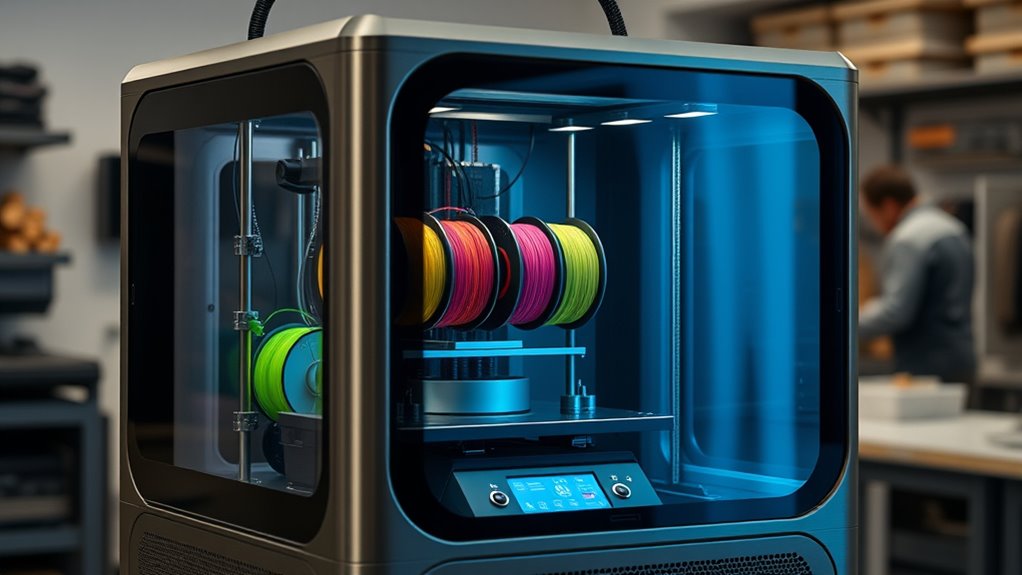
When selecting an enclosed 3D printer, I focus on safety features and how well the enclosure is designed to protect users. I also consider the range of compatible materials and whether the printer maintains stable temperatures during operation. Additionally, I look at noise levels, ventilation options, and how easy it is to calibrate the machine for consistent results.
Safety and Enclosure Design
Choosing an enclosed 3D printer involves more than just looking at print quality and build volume; safety features and enclosure design play a crucial role in ensuring a secure and reliable printing environment. An enclosure protects users from hot components and moving parts, reducing the risk of burns or accidents. It also helps contain fumes, VOCs, and particulates, making indoor printing safer, especially with materials like ABS and ASA. A well-designed enclosure maintains a stable thermal environment, minimizing warping and layer splitting caused by temperature fluctuations. Safety features like interlock doors, filters, and automatic shutoff mechanisms add extra layers of protection, preventing accidental contact or hazards. Proper enclosure materials and construction not only enhance safety but also reduce noise and contain filament debris or failures.
Material Compatibility Range
Considering the variety of filament materials available, evaluating an enclosed 3D printer’s material compatibility range is essential for selecting the right model. Enclosed printers generally support a wide array of filaments like PLA, ABS, PETG, and specialty options such as TPU and ASA, thanks to their stable temperature environment. Many models feature heated chambers reaching 65°C or higher, which helps with high-temperature filaments like ABS and ASA, reducing warping and improving layer adhesion. Compatibility with advanced materials like carbon fiber-reinforced or nylon-based filaments depends on the hotend’s max temperature and consistent heat maintenance. Additionally, handling flexible or abrasive filaments, such as TPU or metal-infused composites, may require reinforced nozzles. The enclosure’s design influences odor containment but can also limit the use of low-temp or cooling-sensitive materials.
Temperature Stability Features
Temperature stability is a critical factor in ensuring high-quality 3D prints, especially with enclosed models that aim to maintain consistent conditions. Enclosed printers often feature temperature-controlled chambers that keep ambient conditions stable, reducing warping and layer separation. Many models include active air filtration systems, like HEPA or activated carbon filters, to manage fumes and VOCs, which helps preserve airflow and temperature consistency. The enclosure minimizes external influences such as drafts and temperature fluctuations, preventing print defects. Some printers even incorporate temperature sensors and automatic climate regulation to monitor and adjust internal conditions in real-time. This consistent chamber temperature is especially beneficial for high-temp materials like ABS and PETG, as it prevents rapid cooling and uneven heat distribution, resulting in better adhesion and smoother layers.
Noise and Ventilation
While enclosed 3D printers are generally quieter than open-frame models, they still produce noise from fans and stepper motors that can be noticeable in quiet environments. Most operate around 50dB, which is manageable but may still be distracting. Proper ventilation is vital to safely vent fumes and particulate matter, especially when printing with materials like ABS or PETG that emit VOCs. Many models include built-in filtration systems, such as HEPA or activated carbon filters, to improve indoor air quality. Good ventilation design not only helps remove fumes but also prevents heat and fumes from accumulating inside the enclosure, reducing safety risks. Balancing effective ventilation with noise control is essential to create a safe, quiet, and efficient printing environment.
Ease of Calibration
When choosing an enclosed 3D printer, ease of calibration is a key factor that can save you time and frustration. Many models feature automatic bed leveling and auto-calibration systems that eliminate manual adjustments, ensuring consistent first layers. Auto calibration sensors, like pressure sensors or proximity detectors, make setup straightforward by automatically detecting build platform height and correcting deviations. Software-based auto calibration tools that run at startup further reduce the need for user intervention and calibration expertise. Hardware features such as dual Z-axis lead screws or auto bed leveling probes help compensate for bed unevenness, simplifying calibration. Overall, printers designed with minimal manual adjustments—requiring only initial setup or occasional checks—offer a more user-friendly experience, especially for those new to 3D printing.
Maintenance Requirements
Regular maintenance is essential to keep an enclosed 3D printer operating smoothly and producing high-quality prints. I regularly clean the chamber and filtration systems to maintain air quality and prevent filament debris buildup. Checking and replacing filters, like HEPA or activated carbon, is vital for effective filtration of VOCs and particles. I also inspect the enclosure’s seals and doors periodically for wear or damage, preventing fumes and dust from escaping. Moving parts such as rails, belts, and fans need routine lubrication and tightening to guarantee consistent performance and reduce failures. Additionally, I monitor components like heated beds and extruders for wear or clogging, calibrating or replacing them as needed. Staying on top of these tasks keeps my printer reliable and ensures superior print quality.
Size and Portability
Choosing an enclosed 3D printer often hinges on its size and portability, especially if you need to move it between workspaces or fit it into a small area. Many models have compact designs, typically under 20 inches in each dimension, making them easier to set up and relocate. The weight varies from around 15 to 60 pounds, impacting how often you can move the printer or transport it elsewhere. Features like built-in handles, lightweight frames, or modular components improve portability further. When selecting a model, consider whether its size and weight match your workspace constraints and transportation needs. A smaller, lighter printer offers greater flexibility, but ensure it still meets your printing volume requirements for safe and precise results.
Frequently Asked Questions
How Do Enclosed 3D Printers Improve Safety During Operation?
The current question about enclosed 3D printers’ safety is important. I believe they improve safety by containing fumes and hot surfaces, reducing exposure to harmful particles and burns. The enclosure also prevents accidental contact with moving parts, keeping users safe. Additionally, it helps maintain a stable temperature, preventing fires or malfunctions. Overall, enclosed printers create a safer environment, especially in shared or educational spaces.
What Maintenance Is Required to Keep Enclosed 3D Printers Functioning Optimally?
Think of your enclosed 3D printer as a finely tuned orchestra. To keep it singing smoothly, I regularly clean the print bed and replace worn nozzles. I check the filters and vents, making sure nothing’s clogged, like a clear path for creativity. Lubricating moving parts and updating firmware keeps the system humming. With these simple steps, my printer stays reliable, delivering precise prints with minimal fuss.
Can Enclosed 3D Printers Handle Flexible or Exotic Filament Materials?
You’re wondering if enclosed 3D printers can handle flexible or exotic filaments. I’ve found that many models are quite capable with flexible materials like TPU or TPE, thanks to their enclosed environment that reduces warping. However, I recommend checking the specific printer’s compatibility and extruder design, as some might need modifications or specialized hotends. Overall, many enclosed printers do a good job with these challenging filaments.
How Do Noise Levels Compare Between Enclosed and Open 3D Printers?
You’re wondering how noise levels compare between enclosed and open 3D printers. From my experience, enclosed printers tend to be quieter because the casing dampens the noise produced by motors and fans. Open printers can be louder, especially during high-speed printing or when cooling fans ramp up. If noise is a concern for your workspace, an enclosed model might be the better choice for a quieter, more peaceful printing environment.
Are Enclosed 3D Printers Suitable for High-Temperature or Industrial Applications?
Think of enclosed 3D printers as the fortress guarding your creations. They’re highly suitable for high-temperature and industrial applications because their design contains heat and fumes, ensuring safety and stability. I’ve found that their insulation allows for consistent, precise results even with demanding materials. If you’re tackling complex, high-heat projects, an enclosed printer offers the robustness and safety needed to bring your visions to life reliably.
Conclusion
Imagine choosing an enclosed 3D printer as selecting a sturdy lighthouse amid turbulent seas. Each model offers its own guiding light—precision, speed, safety. By considering your needs, you’ll find the perfect beacon to steer your creative voyage smoothly. With the right choice, you’ll navigate complex projects confidently, knowing you’re protected and in control. Let this list be your lighthouse, illuminating your path to safe, precise, and successful 3D printing.

